Great Gull Island
By Joan Becker
Photographs by Richard L. Becker
Page 3
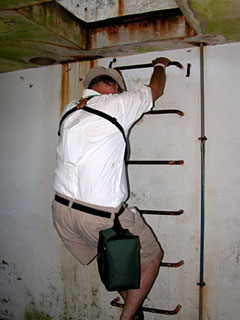 We were divided into three separate groups for our island tour. Our
first stop was the 3-story tower.
The scaling concrete walls and somewhat difficult climb
were quickly overcome by a spectacular view: Little Gull Island to our northeast
(with a spire lighthouse), Plum Island to the southwest (home of a Center for
Disease Control outpost, and the probable source of the island’s lone raccoon,
but more on him later) and Gardiner’s Island to the south (a privately-held
island the family is no longer able to afford and which concerned citizens are
trying to save from pending German developers). Although we left the Connecticut
shore at slack
tide, enough time had passed that we were now mid-tide and could see the force
and turbulence of the current rushing into Peconic Bay (between the north and
south forks of Long Island).
We were divided into three separate groups for our island tour. Our
first stop was the 3-story tower.
The scaling concrete walls and somewhat difficult climb
were quickly overcome by a spectacular view: Little Gull Island to our northeast
(with a spire lighthouse), Plum Island to the southwest (home of a Center for
Disease Control outpost, and the probable source of the island’s lone raccoon,
but more on him later) and Gardiner’s Island to the south (a privately-held
island the family is no longer able to afford and which concerned citizens are
trying to save from pending German developers). Although we left the Connecticut
shore at slack
tide, enough time had passed that we were now mid-tide and could see the force
and turbulence of the current rushing into Peconic Bay (between the north and
south forks of Long Island).
Due in
part to the excessive heat, the flush of excitement once in the tower, and
rushing from side to side to compare views, I came darned close to walking right
over the hole in the floor for the climb down. Assuming I might not be the only
twit to do that, I blocked off two sides with the only plastic chairs available.
Terns
were everywhere, fishing, soaring, landing, and feeding young. Occasionally
large groups would flush for no obvious reason. An Osprey or even a Rock Pigeon
could spook them. Other than terns, we spotted Barn Swallows, one Red-winged
Blackbird, and a couple of American Oystercatchers which we spotted later.
Sometimes erratics like Sooty Tern and Magnificent Frigatebird are blown in by
coastal storms. The
sheer numbers of terns and rugged terrain manage to deter gulls. (In spite of
the milkweed on the island, the only butterflies we saw were Cabbage Whites.)

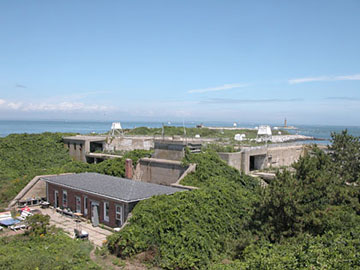
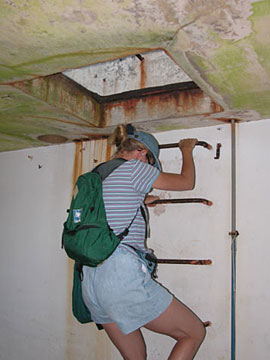 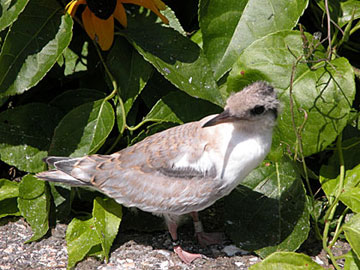 Back
down the stairs and through the thigh-high vegetation to the dorm, I finally
“got” that Helen meant for us to watch out for the “chicks” (not ticks!). And
there were plenty around. One poor fellow had a “weeping” non-functional eye -
Helen hopes he had merely brushed too close to some vegetation and that it might
actually heal. I’m sure she’ll investigate him further once we leave. Back
down the stairs and through the thigh-high vegetation to the dorm, I finally
“got” that Helen meant for us to watch out for the “chicks” (not ticks!). And
there were plenty around. One poor fellow had a “weeping” non-functional eye -
Helen hopes he had merely brushed too close to some vegetation and that it might
actually heal. I’m sure she’ll investigate him further once we leave. |
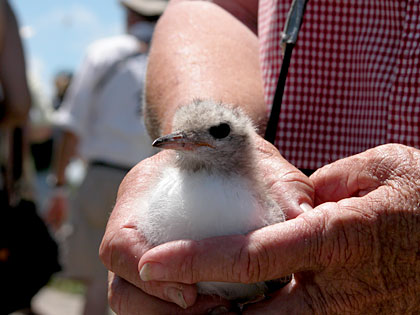
The dorm
rooms were not exactly inviting. Musty-smelling, and almost abandoned looking
except for the occasional sleeping bag strewn here and
there on cots, I knew that only being bone-tired could make them appealing.
We were able to spot our first Roseate Terns out the back door. Expecting
all-black, more slender bills made the adjustment to 1/3 black, 2/3 red bills a
difficult one, but we (sort of) managed to “get it.” Richard even spotted one
with a roseate breast.
And another page
Go to the SongStar home page
Drop us a note
Copyright © 2004 by Joan and Richard
L. Becker
 We were divided into three separate groups for our island tour. Our
first stop was the 3-story tower.
The scaling concrete walls and somewhat difficult climb
were quickly overcome by a spectacular view: Little Gull Island to our northeast
(with a spire lighthouse), Plum Island to the southwest (home of a Center for
Disease Control outpost, and the probable source of the island’s lone raccoon,
but more on him later) and Gardiner’s Island to the south (a privately-held
island the family is no longer able to afford and which concerned citizens are
trying to save from pending German developers). Although we left the Connecticut
shore at slack
tide, enough time had passed that we were now mid-tide and could see the force
and turbulence of the current rushing into Peconic Bay (between the north and
south forks of Long Island).
We were divided into three separate groups for our island tour. Our
first stop was the 3-story tower.
The scaling concrete walls and somewhat difficult climb
were quickly overcome by a spectacular view: Little Gull Island to our northeast
(with a spire lighthouse), Plum Island to the southwest (home of a Center for
Disease Control outpost, and the probable source of the island’s lone raccoon,
but more on him later) and Gardiner’s Island to the south (a privately-held
island the family is no longer able to afford and which concerned citizens are
trying to save from pending German developers). Although we left the Connecticut
shore at slack
tide, enough time had passed that we were now mid-tide and could see the force
and turbulence of the current rushing into Peconic Bay (between the north and
south forks of Long Island). 



